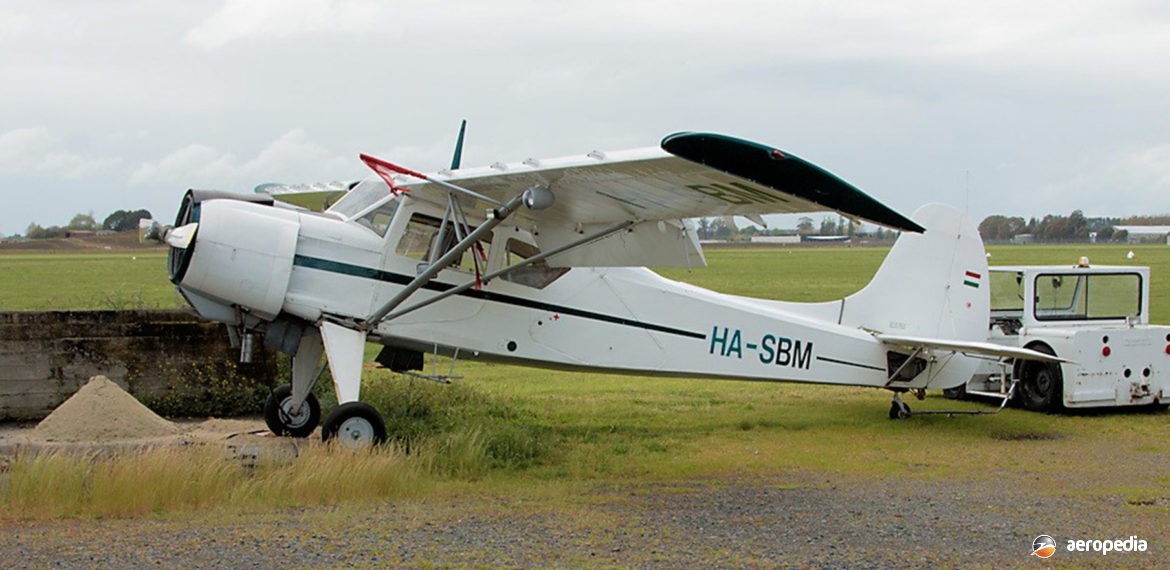Photograph:
PZL Gawron HA-SBM (c/n 119295) in its Hungarian markings at Hamilton, New Zealand in late 2019 (Peter Lewis –NZCIVAIR)
Country of origin:
Poland
Description:
Single-engine utility aircraft
Power Plant:
One 194 kw (260 hp) Ivchenko AI-14R nine-cylinder air-cooled radial engine
Specifications:
- Wingspan: 12.60 m (41 ft 4 in)
- Length: 9.00 m (29 ft 6 in)
- Height: 3.12 m (10 ft 3 in)
- Wing area: 23.86 m² (256.8 sq ft)
- Max speed: 160 km/h (99 mph)
- Economical cruising speed: 130 km/h (81 mph)
- Stalling speed, flaps down: 50 km/h (31 mph)
- Service ceiling: 3,200 m (10,499 ft)
- Rate of climb: 180 m/min (590 ft/min)
- Take-off run in agricultural role: 102 m (335 ft)
- Landing run in agricultural role: 90 m (295 ft)
- Range: 525 km (326 miles)
- Fuel capacity: 180 litres (40 Imp gals)
- Empty weight: 642 kg (1,415 lb)
- Loaded weight: 1,660 kg (3,660 lb)
- Power loading: (14 lb/hp)
History:
The PZL 101 Gawron is a single engine rugged utility aircraft which was built in some numbers in Poland for the Eastern Europe market, being produced by WSK-Okecie, this company later becoming known as PZL Warszawa-Okecia and is a development of the Soviet-built Yakovlev Yak 12M. It was licence-built to meet the needs of agricultural and forestry services. The type was designed as a four-seat utility aircraft and has been used for glider towing, crop spraying, ambulance and dusting operations.
As it has been used in the agricultural role extensively, the aircraft is of steel tube structure with fabric covering, being fully protected against corrosive chemicals, forward of the cockpit and the wing leading edges being metal. A transverse steel tube located the hopper but the latter could be replaced by seats and a triangular door in the rear allowed straight-in loading of stretchers. It has a two-spar wing, also fabric covered with slotted flaps, slats and vertical edge plates at the wing tips. In the agricultural role it could carry 800 litres (176 Imp gals) of liquid or 500 kg (1,102 lb) of chemicals behind the front seats. It was supplied with exchangeable equipment for spraying or cropdusting. The wheel brakes and flaps were pneumatically operated from an engine-charged compressed-air bottle.
Three basic variants were built, the initial model being the PZL 101 which was produced between 1960 and 1962, followed by an improved model known as the PZL 101A with improved equipment and a door on the right side which was produced from 1962 to 1965. Final variant was the PZL 101B which was further improved and had the bulge above the fuselage removed and a larger air intake, being produced up to 1968. First flight was on 14 April 1958 and 325 examples were produced, aircraft being supplied to a number of countries, including Hungary, India, Turkey and Bulgaria. About 32 were built for ambulance duties. Eventually by the 1970s the type was replaced in Polish service by the PZL 106 Kruk. An example is on display (SP-WAK) at the Polish Aviation Museum at Krakow.
A number have remained in private use in eastern Europe and are flown as general aviation aircraft. The first example of the type seen in this part of the World arrived in New Zealand in late 2019, this aircraft, a Model 103A Gawron HA-SBM (c/n 119295) having formerly been operated in the skydiving role in Hungary by Avia-Rent KFT before its importation to Hamilton. On 6 May 2021 it was registered as ZK-ORO to BOP Marine Life Trust pf Tauranga.

